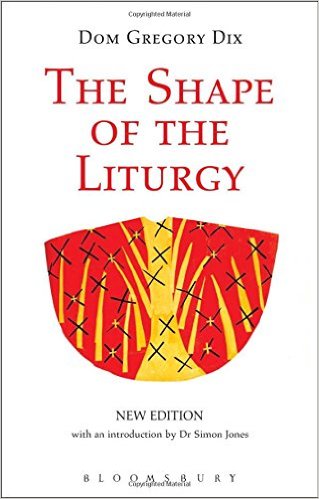 Jeg har nå lest ferdig den ganske berømte The Shape of the Liturgy, av Dom Gregory Dix, og er faktisk ikke så veldig fornøyd med boka.
Jeg har nå lest ferdig den ganske berømte The Shape of the Liturgy, av Dom Gregory Dix, og er faktisk ikke så veldig fornøyd med boka.
Jeg syntes faktisk han var ganske preget av det man kaller arkeologisme, som pave Pius XII fordømte på 50-tallet, men som en del liturger likevel var og er påvirket av. F.eks. tenker Dix seg at på 100- og 200-tallet – da han mener at ordets gudstjeneste (synaxi) og eukaristien ble feiret separat – kunne søndagens eukaristi tidlig om morgenen var kanskje ikke mer enn 20 minutter, og være et nokså typisk måltidsfellesskap (selv om offertanken også var med). Preken (og bibellesninger) skulle altså holdes på et annet tidspunkt, men det har jeg nok litt vanskelig for å se for meg. Dix mener også at alterets posisjon fram til ca 700 var at biskopen/presten var vendt mot folket (men han skriver litt om dette emnet).
I det hele tatt er Dix nesten bare opptatt av det som skjedde fra til år 600 – selv om han skriver litt om forandringene rundt år 800 (med Karl den store) og enda mindre om utviklingen senere i middelalderen – og det han skriver om de første århundrene i øst og vest virker ganske spekulativt.
En ganske grundig anmeldelse av boka skriver bl.a.:
… Later scholarship has considered Dix to be near the mark but not always on it. For example, Dix argued that the Eucharistic Prayer grew out of a solemn three-part Jewish prayer, the Birkat ha-Mazon, or blessing after a meal, and, in particular, out of its second paragraph of “thanksgivings.” More recent liturgical scholarship has sought its origin in all three paragraphs of this ancient prayer, which, however, did not harden into prescribed forms among the Jews until the end of the first Christian millennium. This makes it difficult to reconstruct more than an outline of the original prayer. At best, it can be summarized as blessing-thanksgiving-supplication, and modern scholarship has criticized Dix for assuming, in a Jewish prayer context, the equivalence of blessing (Hebrew, berakah) and thanksgiving (Hebrew, yadah).
Dix also assumed, following late nineteenth- and early twentieth-century German scholarship, that in the early Church the celebrant of the Eucharistic liturgy faced the congregation over the altar. The popularity of his book did a great deal to foster that practice among Anglicans and certain “catholicizing” clergy and congregations among Protestants such as Lutherans and Methodists.
It may have had a similar effect on Roman Catholics in laying the groundwork for the “reversal of the altars” that swept like a tidal wave over the Roman Rite of the Catholic Church from 1965 onwards. But this was more likely due to the influence of German and French liturgical institutes (most of whose “experts” were “popularizers” of liturgical scholarship rather than scholars themselves). Also, the view that “facing the people” was the “primitive practice” had been enshrined in the English-speaking world in The Catholic Encyclopedia of 1913, and had come to be regarded as historical fact.
However, this view is now acknowledged to be mistaken by most contemporary liturgical scholars: The universal early Christian practice of facing east for prayer applied also, and especially, during the celebration of the Eucharist. ….
…. Some have marveled at how much he was able to do by way of digestion, assimilation, and “regurgitation” under highly adverse conditions, even if at some haste. So his scholarship has been characterized as brilliant but at the same time “erratic” or even “slipshod.”
